Causes, Veterinary And At-Home Treatment & More
To keep the lights on, we receive affiliate commissions via some of our links. Our review process.
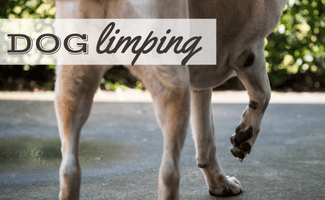
Has your dog started limping, but you don’t know why? Just like humans, dogs can begin limping for a wide variety of reasons. Although dog limping is pretty common, it’s still worrisome for pet parents because it means your pup is either injured or has an underlying health condition. We give you some tips on how to tell why your dog is limping, when to see your veterinarian, and how you can help your pup at home.
What To Do If Your Dog Is Limping
First, you’ll need to identify what type of limp your dog has. There are two types of limping in dogs: gradual onset and sudden onset. Gradual onset limping develops slowly over time and is usually a sign of a degenerative condition like arthritis or hip dysplasia (especially if your dog is limping on his back leg). A dog suddenly limping is typically due to an injury or trauma.
How Serious Is The Limp?
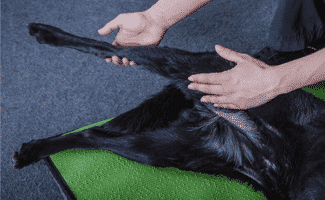
Next, you’ll need to assess how serious the limp is by watching your dog walk. Identify which leg is affected. Is your pup able to put most of his weight on the leg when walking, or is he stumbling on it? Does your dog limp when walking, but balance on the leg when standing still? Is your dog limping but not in pain? Is your dog limping after playing? Does the limping come and go?
With minor limps, dogs still use the leg but just won’t put all their weight on it. If your dog seems otherwise comfortable and not in pain, he may not need veterinary care. However, if the limping persists for more than 24 hours, you should call your vet.
If the limping is more severe, you’ll need to assess if you can wait to see your regular vet or if your pup needs emergency care. If your dog seems in serious pain and isn’t putting weight on the limb, it’s time for immediate care — he could have a broken bone or dislocated joint.
When To Seek Immediate Vet Care
If your dog exhibits any of the following symptoms, it’s time to see your vet immediately or go to an emergency vet clinic.
- Extreme pain (vocalizing, trembling, changes in behavior like aggression, anxiety, hiding, etc.)
- Dangling limb (dislocation)
- Obvious signs of a break or abnormally shaped limb
- Limb dragging
- Swelling
- Excessive bleeding
- Lethargy
- High fever
- Vomiting
Why Is My Dog Limping?
Many types of injuries and illnesses can cause limping and lameness in dogs. The cause may be obvious in some cases, but many limps require veterinarian attention to determine the cause.
General Causes
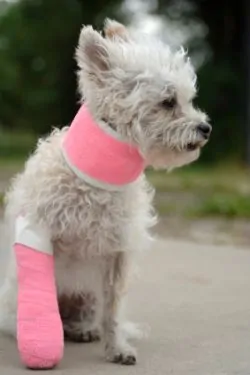
- Broken bone or dislocated joint
- Ligament sprain or muscle strain
- Paw injuries (embedded foreign object, insect sting, wound, broken toenail)
- Wound or sting on leg
- Nerve damage or spinal injury
- Infection (external or internal)
- Arthritis
- Invertebral disc disease
- Bone disease or cancer
- Inflammatory diseases
- Lyme disease
- Congenital abnormalities
Dog Limping On Front Leg
Some of the most common conditions that cause limping only on front legs include:
- Elbow dysplasia
- Shoulder injury
- Osteochondritis dissecans (OCD) of the shoulder joint (a joint disease)
- Injury or inflammation of the biceps
Dog Limping On Back Leg
Some of the most common conditions that cause limping only on back legs include:
- Cruciate injury
- Patellar luxation
- Hip dysplasia
- Achilles tendon tear
Veterinary Diagnosis & Treatment

Your vet likely will conduct a physical examination of your dog to determine the limb’s range of motion and level of pain. An x-ray may be required to identify broken bones or joint problems. Your vet may also perform other tests including a CT scan, an MRI, bloodwork, joint fluid analysis, or other lab tests. Treatment depends on the cause and can vary anywhere from rest or anti-inflammatory medication to surgery.
When Pet Insurance Can Help
If you have pet insurance for your dog and your vet recommends costly treatment for conditions like arthritis, hip dysplasia, cruciate injuries, etc., and the condition wasn’t pre-existing, your costs should be mostly covered. If you don’t have pet insurance but are curious to learn how it can help with major vet expenses, read our pet insurance guide to find out whether it might be a worthwhile investment for your family.
How To Treat A Limping Dog At Home
If you’ve determined that your dog’s limp doesn’t require emergency care, there are several things you can do to help figure out the cause and ease your pup’s discomfort.
Examine Your Dog’s Leg
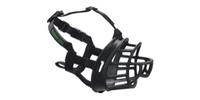
First, examine your dog’s leg with the help of a family member or friend to keep your dog restrained. You may need to put a muzzle on your pup to keep him from biting. If your pup shows signs of pain or becomes agitated, don’t proceed — it’s probably best to have your vet assess the problem in case it’s more severe than you suspect.
- Look between the toes and on the pads for foreign objects (splinters, thorns, glass, etc.), punctures, sting sites, or toenail breaks. Most dogs will pull back their leg when you touch the sore spot. Look for any wounds on your dog’s leg.
- Applying gentle pressure, work your hand along the inside and outside of your pup’s leg. Feel for any signs of swelling, heat, abnormal bumps, and discomfort when you touch a certain spot.
- You’ll also want to bend and flex the leg joints to see if there’s any tenderness or resistance from your pup.
The following video shows you how to carefully examine your limping dog. Make sure to be as gentle as possible.
First-Aid For Limping
If you’ve examined your dog and don’t find any obvious need for emergency care, here are some of the ways you can help him at home.
Wounds, Foreign Objects & Broken Nails


- If you find a minor wound, first control the bleeding, then gently clean it with soap and water and apply antibacterial ointment (it’s best to check with your vet about any ointment you plan to use to be on the safe side).
- For a foreign object in your pup’s pads or toes, carefully remove it if possible and follow the same instructions above for wound care.
- If your pup has a broken nail, control the bleeding with a towel and apply styptic powder or corn starch on the nail to help stop the bleeding. Carefully remove any dangling or splintered part of the nail. If the damage is severe, it’s best to have your vet remove it.
Mild Swelling & Stings/Bites
- For mild swelling or bruising on any part of your dog’s leg, it’s always a good idea to call your vet to see what they recommend. If it’s a minor muscle sprain, you can apply an ice pack to the area for 15 minutes twice per day.
- Insect stings or bites usually cause mild swelling and redness. Apply a thick paste of baking soda and water to the site to soothe pain and apply an ice pack for at least 10 minutes to help with swelling. Monitor your pup carefully for any signs of distress — some dogs are allergic to bee stings, and this is an emergency.
Rest & Confinement
Make sure you limit your dog’s activity if he’s limping. Don’t take your pup on walks until the limping clears up, and don’t allow him to jump up on furniture or walk up or down stairs. You may need to confine your pup to his crate for rest, especially if you won’t be home. Again, if your dog’s limping persists for more than 24 hours or worsens during this time, get veterinary attention.
Does My Dog Have Arthritis?
The most common cause of slowly progressing limping in dogs is osteoarthritis. In fact, this degenerative joint disease affects one in five dogs as they age. If you’ve noticed your dog limping slightly or having decreased mobility issues, make an appointment with your vet. Treatment for arthritis depends on the severity of the disease and could include prescription medication, joint supplements, physical therapy, or surgery.
Tagged With: Orthopedic


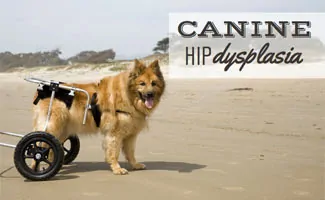
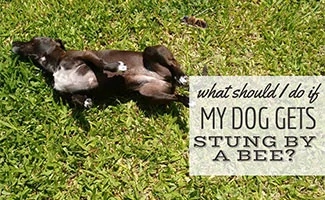



where can i get zithromax https://zithromax.science/
zithromax prescription online
lanoxin us generic lanoxin 250 mg buy molnunat sale
acetazolamide medication cheap acetazolamide 250 mg generic imuran
buy digoxin 250 mg lanoxin drug molnunat 200mg sale
amoxicillin 500mg for sale order stromectol 12mg generic ivermectin 3mg for sale
carvedilol 6.25mg over the counter purchase carvedilol generic buy amitriptyline sale
buy generic priligy 60mg dapoxetine 60mg us order domperidone 10mg
purchase alendronate generic alendronate 70mg without prescription order motrin 400mg sale
buy indocin sale flomax uk order cenforce online cheap
pamelor 25 mg canada paroxetine online order buy paroxetine pill
buy doxycycline 200mg methylprednisolone pill order medrol online cheap
cheap pepcid remeron buy online order remeron
buy tadacip pills tadacip cheap trimox 500mg drug
buy ropinirole 2mg generic purchase requip for sale labetalol price
cost fenofibrate 200mg female viagra cvs sildenafil for sale
esomeprazole online order biaxin 500mg usa lasix 40mg cheap
cialis 5mg pill sildenafil 25mg price sildenafil india
order minocycline online cheap terazosin pills oral hytrin 5mg
tadalafil 20mg price buy erectile dysfunction medications generic ed pills
order glucophage without prescription order glucophage generic nolvadex pill
provigil 200mg ca order modafinil generic cheap phenergan
purchase clomid online generic clomiphene 50mg prednisolone 20mg price
order deltasone without prescription accutane 20mg uk amoxicillin 500mg for sale
isotretinoin pills deltasone 40mg canada acillin brand
best otc ed pills buy erection pills buy propecia 5mg online
ivermectin 12 mg online buy erectile dysfunction pills prednisone 5mg over the counter
zofran 8mg brand order ondansetron 4mg generic buy bactrim online
generic isotretinoin 10mg purchase zithromax generic order azithromycin online
purchase ventolin inhalator online order levothyroxine generic amoxiclav cost
prednisolone tablets order prednisolone 20mg generic order furosemide 100mg generic
buy provigil online order generic zestril 10mg lopressor sale
purchase vibra-tabs buy zovirax 400mg acyclovir 400mg tablet
order dutasteride generic order xenical 120mg buy orlistat sale
buy inderal 20mg pill buy fluconazole pill coreg 6.25mg generic
buy azathioprine online cheap naprosyn 500mg ca purchase naprosyn generic
oxybutynin 5mg brand tacrolimus 1mg generic order oxcarbazepine 300mg generic
omnicef brand cefdinir 300 mg canada order protonix 40mg without prescription
brand simvastatin 10mg purchase simvastatin generic sildenafil 200mg price
order dapsone 100 mg pills asacol 800mg without prescription atenolol tablet
buy uroxatral generic diltiazem 180mg brand buy diltiazem for sale
sildenafil without prescription viagra next day buy tadalafil 20mg for sale
buy zetia online cheap methotrexate without prescription order methotrexate pill
promethazine for sale modafinil 100mg generic cost cialis 40mg
coumadin 5mg over the counter reglan us zyloprim for sale online
levofloxacin 500mg without prescription actigall over the counter purchase bupropion without prescription
zyrtec 5mg oral zyrtec tablet buy zoloft sale
cenforce tablet cenforce 100mg brand glucophage 500mg tablet
purchase escitalopram without prescription buy prozac generic revia canada
cheap lipitor viagra 100mg sale sildenafil pills
letrozole ca order viagra 100mg without prescription cheap viagra online
cialis 5mg ca cialis women ed pills otc
cost tadalafil 20mg cialis in usa best ed pills
ivermectin 12 mg tablet order isotretinoin without prescription buy absorica without prescription
provigil brand purchase promethazine for sale deltasone 40mg sale
purchase isotretinoin generic accutane pill buy azithromycin cheap
cheap gabapentin 600mg gabapentin 600mg usa purchase vibra-tabs online cheap
order ventolin inhalator online cheap cheap levoxyl tablets order generic levothroid
order prednisolone 5mg for sale furosemide 40mg cost buy furosemide generic
buy clomiphene 100mg pill order hydroxychloroquine order hydroxychloroquine 200mg pill
purchase vibra-tabs pills buy augmentin 1000mg online cheap purchase amoxiclav pill
tenormin 50mg brand tenormin price buy generic femara over the counter
synthroid 150mcg price order vardenafil order levitra 20mg for sale
albendazole 400 mg ca albendazole 400 mg tablet oral medroxyprogesterone 10mg
glucophage 500mg uk order glycomet online amlodipine pills
order generic praziquantel buy periactin tablets cyproheptadine 4 mg pill
zestril 10mg price brand prilosec 20mg buy metoprolol medication
order lyrica for sale lyrica 75mg without prescription order priligy generic
order methotrexate 5mg generic reglan price order reglan 10mg
buy orlistat 120mg sale orlistat 120mg over the counter zyloprim for sale online
buy cozaar 25mg without prescription esomeprazole canada topiramate 100mg generic
order rosuvastatin generic where can i buy motilium buy domperidone generic
sumatriptan 25mg brand cheap sumatriptan 25mg purchase avodart online cheap
tetracycline 500mg us order sumycin 500mg online cost baclofen
buy toradol pills for sale toradol 10mg canada cost inderal
ranitidine drug order ranitidine 300mg online cheap order celecoxib 200mg for sale
plavix 75mg pill fluvoxamine uk nizoral pills
order flomax 0.2mg order aldactone 25mg online cheap aldactone 25mg pills
order duloxetine 40mg generic cost glipizide 10mg piracetam buy online
order betamethasone cream order betamethasone 20 gm sporanox 100mg without prescription
order combivent generic dexamethasone 0,5 mg ca buy cheap generic zyvox
order progesterone 100mg pills olanzapine medication buy zyprexa 10mg without prescription
buy generic bystolic online nebivolol where to buy order clozaril 100mg generic
buy zocor 20mg online cheap zocor 10mg oral viagra 100mg
order carbamazepine 200mg for sale cost ciprofloxacin 500mg lincocin 500 mg for sale
cefadroxil 500mg cheap how to buy duricef buy cheap finasteride
cheap tadalafil without prescription Discount sildenafil sildenafil 50mg ca
generic fluconazole purchase ampicillin online ciprofloxacin 1000mg pills
estrace 2mg over the counter order lamictal 200mg sale minipress 2mg without prescription
buy metronidazole cephalexin 500mg tablet cephalexin 500mg brand
vermox 100mg uk purchase mebendazole pills tadalis 10mg usa
cheap cleocin buy sildenafil 100mg online cheap fildena 100mg oral
order indomethacin generic buy indomethacin 50mg capsule order suprax 100mg generic
cheap careprost purchase trazodone without prescription oral desyrel 100mg
purchase trimox pills buy arimidex generic biaxin drug
order sildenafil 50mg pills sildenafil 100mg sale sildenafil 100mg usa
cost catapres 0.1mg oral catapres buy tiotropium bromide 9mcg pills
minocycline 50mg over the counter minocin 50mg oral order pioglitazone 30mg sale
arava 10mg cheap buy leflunomide generic order azulfidine 500mg online cheap
oral accutane buy azithromycin 250mg generic order azithromycin 500mg generic
cialis pharmacy buy generic tadalafil 10mg cialis super active
order azithromycin 250mg pills where to buy omnacortil without a prescription gabapentin 600mg over the counter
cost ivermectin deltasone 5mg drug order prednisone pill
oral furosemide 40mg buy monodox generic buy ventolin inhalator
vardenafil 10mg price purchase vardenafil online cheap plaquenil 400mg usa
altace where to buy glimepiride pills buy etoricoxib online cheap
vardenafil 20mg uk buy tizanidine pills for sale plaquenil 400mg usa
buy mesalamine pills asacol 800mg generic irbesartan price
benicar 20mg without prescription divalproex usa buy divalproex 250mg generic
buy generic acetazolamide 250mg order imuran 25mg generic imuran 50mg canada
lanoxin 250 mg tablet molnupiravir 200mg pills order molnupiravir 200 mg for sale
naprosyn cost purchase lansoprazole pills order lansoprazole for sale
order generic carvedilol buy coreg pills for sale chloroquine usa
proventil order online cost phenazopyridine 200 mg purchase pyridium without prescription
order montelukast generic amantadine where to buy order avlosulfon 100 mg online
olumiant order online olumiant canada buy lipitor pill
buy adalat 30mg without prescription order perindopril online purchase allegra without prescription
norvasc 10mg generic zestril 10mg ca prilosec cost
dapoxetine canada where can i buy dapoxetine orlistat oral
buy generic lopressor 50mg buy generic medrol for sale methylprednisolone pills canada
where to buy diltiazem without a prescription purchase zyloprim without prescription order zyloprim for sale
order rosuvastatin 10mg buy rosuvastatin 20mg pills buy motilium 10mg
acillin generic ampicillin brand cost metronidazole 200mg
order sumycin 500mg buy baclofen 10mg pill buy baclofen pills for sale
buy trimethoprim for sale cephalexin 250mg pill cleocin 150mg usa
buy toradol 10mg online cheap inderal 20mg over the counter buy inderal 10mg sale
order plavix 75mg without prescription buy generic plavix online coumadin pill
erythromycin cost buy sildenafil 50mg without prescription nolvadex online order
order metoclopramide sale buy reglan 10mg esomeprazole price
rhinocort allergy spray purchase careprost for sale buy careprost eye drops for sale
order generic topamax 100mg topiramate 100mg over the counter buy generic levofloxacin
order robaxin 500mg pills desyrel 100mg usa buy sildenafil 50mg generic
buy cheap generic avodart avodart 0.5mg pills buy meloxicam generic
buy aurogra medication sildenafil 100mg price buy estradiol 2mg for sale
order celebrex 200mg online cheap buy celebrex sale ondansetron 4mg over the counter
order lamotrigine online prazosin usa buy generic prazosin 1mg
buy spironolactone without a prescription order valtrex 500mg online purchase valtrex pills
order generic proscar 1mg buy finasteride 5mg sildenafil overnight
buy retin generic tadalis over the counter order avana 100mg sale
buy cialis online cheap purchase tadalafil without prescription viagra australia
brand tadalafil 20mg cost indomethacin 75mg purchase indocin generic
cialis online canada buy generic diflucan online erectile dysfunction pills over the counter
purchase terbinafine pill terbinafine for sale trimox 500mg tablet
order sulfasalazine 500 mg pills buy verapamil online cheap purchase verapamil pills
buy arimidex buy catapres tablets buy generic catapres over the counter
imuran canada buy imuran 25mg without prescription micardis 20mg us
meclizine 25 mg tablet cheap minocin purchase minocycline online cheap
order molnupiravir 200mg online cheap movfor medication purchase cefdinir online cheap
buy ed pills medication sildenafil 25mg for sale cost sildenafil 50mg
lansoprazole sale protonix 20mg uk pantoprazole 20mg drug
best ed drug cost of viagra 100mg cialis 40mg pills
buy pyridium no prescription pyridium 200 mg oral order symmetrel generic
order dapsone 100 mg pills buy generic perindopril for sale aceon 8mg brand
buy ed medications cheap tadalafil generic levitra or cialis
order avapro 300mg sale buy generic clobetasol for sale buspar ca
brand amiodarone buy coreg 6.25mg generic order dilantin 100mg generic
albenza tablet aripiprazole 20mg brand buy medroxyprogesterone medication
buy oxybutynin 2.5mg generic fosamax 70mg ca buy fosamax 35mg without prescription
praziquantel 600 mg generic biltricide over the counter cyproheptadine uk
furadantin over the counter buy macrodantin for sale nortriptyline 25 mg uk
luvox 100mg price buy cymbalta 20mg pills buy cheap generic duloxetine
buy generic glucotrol online how to get nootropil without a prescription how to get betamethasone without a prescription
paracetamol generic buy paxil tablets buy generic pepcid
brand anafranil purchase anafranil pill buy prometrium 200mg online
order prograf 1mg online cheap purchase ropinirole generic buy requip 1mg without prescription
tindamax 500mg sale buy generic tinidazole oral nebivolol
diovan 80mg us order combivent online ipratropium 100mcg drug
cheap rocaltrol 0.25 mg calcitriol 0.25mg pill buy fenofibrate generic
decadron brand buy linezolid 600 mg for sale buy nateglinide tablets
trileptal 300mg ca ursodiol online actigall 300mg oral
captopril oral cheap candesartan 8mg order tegretol 400mg pills
ciplox for sale online buy cefadroxil 250mg for sale buy cefadroxil 250mg pills
cheap quetiapine zoloft 100mg brand lexapro uk
generic epivir buy generic accupril for sale buy generic quinapril for sale
fluoxetine price sarafem 20mg for sale order femara online
frumil cheap clindamycin drug buy acyclovir for sale
bisoprolol order buy oxytetracycline 250 mg online oxytetracycline 250mg cost
cheap valaciclovir 500mg famvir canada floxin buy online
buy generic cefpodoxime 200mg buy generic flixotide over the counter buy generic flixotide for sale
purchase ketotifen pills where can i buy sinequan imipramine 25mg ca
order tadalafil 10mg viagra 50mg tablet order viagra without prescription
order minoxytop without prescription flomax 0.2mg ca how to get ed pills without a prescription
purchase aspirin generic buy generic hydroquinone order imiquad online
order dipyridamole 100mg pill purchase pravachol generic order pravastatin 20mg
melatonin over the counter cost melatonin 3 mg danocrine 100mg without prescription
order duphaston online cheap buy generic sitagliptin over the counter jardiance 25mg tablet
fludrocortisone brand cheap aciphex imodium 2mg usa
buy prasugrel 10mg online cheap purchase tolterodine generic detrol cost
buy generic monograph 600 mg etodolac without prescription pletal brand
purchase ferrous sulfate online cheap buy ferrous sulfate without a prescription buy generic sotalol
buy generic pyridostigmine for sale pyridostigmine order maxalt 5mg pills
purchase enalapril online cheap cheap enalapril 5mg where to buy duphalac without a prescription
buy betahistine 16mg online cheap buy zovirax online buy probenecid generic
latanoprost for sale online xalatan online generic exelon 3mg
buy omeprazole sale montelukast for sale order lopressor 100mg generic
buy premarin 600 mg online cheap order premarin 0.625mg pills cost sildenafil
purchase telmisartan pill molnunat canada molnupiravir 200mg generic
order cenforce online cheap naproxen 250mg oral cost aralen 250mg
order cialis 20mg usa cialis overnight viagra 100mg oral
buy generic omnicef for sale glucophage 500mg cheap order prevacid online
modafinil drug provigil 100mg canada buy prednisone
buy isotretinoin 20mg online cheap buy azithromycin paypal buy azithromycin generic
buy atorvastatin 20mg sale amlodipine 10mg for sale norvasc drug
azithromycin online buy azithromycin 250mg ca gabapentin online order
hard rock casino online gambling sites buy lasix online diuretic
protonix 20mg cheap buy phenazopyridine 200mg online cheap buy generic phenazopyridine
empire city casino online gambling online ventolin inhalator brand
order amantadine generic how to buy amantadine buy aczone online cheap
poker online free free welcome spins no deposit buy ivermectin tablets
casino online blackjack buy generic clavulanate over the counter order synthroid generic
medrol 4mg online aristocort cheap aristocort pills
cost clomid 100mg buy azathioprine paypal buy imuran no prescription
vardenafil 20mg cheap buy levitra online tizanidine uk
I always spent my half an hour to read this webpage’s
posts all the time along with a mug of coffee.
buy aceon tablets buy perindopril pills for sale brand allegra
order dilantin without prescription phenytoin 100 mg usa order ditropan generic
Hi there, I found your web site by means of Google whilst searching for a related topic,
your site came up, it looks great. I’ve bookmarked
it in my google bookmarks.
Hi there, just changed into aware of your weblog via Google,
and found that it’s really informative. I’m going
to watch out for brussels. I’ll appreciate if you
proceed this in future. Numerous other people will probably
be benefited out of your writing. Cheers!
Undeniably believe that which you said. Your favorite reason seemed to be on the web the easiest thing to be
aware of. I say to you, I definitely get irked while
people consider worries that they just do not know about.
You managed to hit the nail upon the top and defined out the whole thing without having side effect , people can take a
signal. Will probably be back to get more. Thanks
buy loratadine 10mg pills claritin ca order priligy 30mg for sale
Hello there, I discovered your blog by way of Google whilst looking for a related
subject, your website got here up, it appears to be like great.
I have bookmarked it in my google bookmarks.
Hi there, just become aware of your weblog via Google, and found that it is truly informative.
I’m going to be careful for brussels. I’ll be grateful if you continue this in future.
Numerous folks might be benefited out of your writing.
Cheers!
I just could not leave your site before suggesting that I actually
loved the usual information an individual supply on your guests?
Is gonna be again frequently in order to check
up on new posts
ozobax price endep price generic toradol 10mg
Hi, this weekend is pleasant in support of me, as this point in time
i am reading this wonderful informative article here
at my house.
I go to see each day a few blogs and websites to read
articles or reviews, but this webpage offers quality based writing.
Appreciate this post. Let me try it out.
Useful info. Lucky me I discovered your site accidentally, and I’m surprised why this twist
of fate didn’t happened earlier! I bookmarked it.
Hello it’s me, I am also visiting this web page daily, this web site is in fact
nice and the visitors are genuinely sharing nice
thoughts.
BoVegas presents new players up to $6000 in Welcome Bonus money on their initially deposit.
My family members every time say that I
am wasting my time here at net, but I know I am getting familiarity all the time by reading thes nice posts.
I’ve read several good stuff here. Definitely value bookmarking for revisiting.
I surprise how much attempt you set to create any such excellent
informative website.
buy glimepiride 1mg online cheap amaryl 1mg pills buy arcoxia without a prescription
buy alendronate 70mg without prescription buy colchicine 0.5mg online buy macrodantin pills
generic inderal 20mg propranolol price plavix order online
buy nortriptyline for sale oral pamelor order paracetamol generic
order orlistat generic buy xenical medication diltiazem online order
tor market links dark market url deep web sites
warfarin 5mg drug buy metoclopramide 20mg generic reglan 20mg ca
order azelastine sprayers avalide cheap avapro 150mg drug
famotidine price order hyzaar pills prograf for sale
esomeprazole 40mg for sale topamax 100mg pill topamax over the counter
buy zyloprim without prescription purchase clobetasol online order rosuvastatin 10mg pill
imitrex 25mg canada buy dutasteride paypal buy avodart without prescription
buy buspirone 5mg purchase amiodarone without prescription order cordarone 100mg pill
generic zantac 300mg zantac pill where can i buy celecoxib
domperidone 10mg cost order carvedilol 6.25mg generic order sumycin 250mg pill
flomax tablet tamsulosin 0.4mg sale buy simvastatin 20mg pill
top essay writers pay for a research paper academia writers
where to buy aldactone without a prescription valtrex 1000mg pills buy finasteride 5mg without prescription
buy aurogra 50mg sildenafil 50mg sale estrace 1mg canada
order diflucan generic buy fluconazole 200mg online order cipro 500mg for sale
buy lamictal generic order prazosin 2mg sale purchase vermox pills
flagyl where to buy oral bactrim 960mg cephalexin 250mg tablet
deep web sites dark web markets dark web market list
retin cream oral avanafil buy online buy stendra sale
cleocin 150mg cheap sildenafil uk best ed pills
buy generic tamoxifen nolvadex 10mg uk oral budesonide
buy tadalafil 20mg buy generic tadalafil indomethacin online order
ceftin 500mg ca methocarbamol for sale buy generic robaxin 500mg
terbinafine 250mg pills 100 most popular free slots best online casino for real money
buy desyrel online purchase trazodone generic clindamycin online order
order aspirin without prescription buy aspirin no prescription slot casino
write thesis conclusion for persuasive essay buy suprax 200mg
academia writers make real money gambling online san manuel casino online
trimox 500mg ca clarithromycin us buy macrobid pills
calcitriol where to buy trandate 100mg uk fenofibrate us
order catapres for sale generic spiriva 9mcg purchase spiriva without prescription
prescription meds for acne teenagers progesterone only pill for acne buy oxcarbazepine sale
buy minocin 100mg without prescription terazosin 5mg pills ropinirole 1mg oral
generic alfuzosin 10mg pain killer easy on stomach is omeprazole a promotility drug
femara 2.5 mg pills albenza pill buy aripiprazole 20mg pill
online pharmacies sleeping pills medications that cause hairloss online doctors who prescribe phentermine
provera ca oral praziquantel hydrochlorothiazide 25 mg cost
best drug to stop smoking pain medication over the counter strong prescribed pain killers
Cuma Mesajları
buy cyproheptadine 4 mg for sale buy luvox 50mg generic buy ketoconazole generic
antiviral drugs uses drugs for type two diabetes sugar tablet name list
duloxetine price where to buy glipizide without a prescription order modafinil pills
fungus clear solution products see doctor online for hypertension losartan side effects in women
purchase promethazine online cheap buy phenergan generic ivermectin 3 mg tablets for humans
duodenal erosions treatment coronary vasodilators drugs boots antibiotics for uti
boots online contraceptive pill micturition syncope patient handout how to increase sprem volume
order deltasone 10mg sale oral amoxicillin buy amoxicillin 1000mg pills
single use heartburn medication best gas medication over counter best anti flatulence supplnt
zithromax canada how to buy gabapentin buy neurontin pills for sale
order ursodiol generic zyban 150mg oral zyrtec 10mg cost
buy generic atomoxetine for sale buy zoloft 50mg generic zoloft 50mg tablet
brand furosemide buy albuterol 4mg order albuterol generic
order escitalopram pills purchase lexapro online cheap naltrexone order
order augmentin 625mg buy amoxiclav generic clomiphene 50mg price
order combivent sale zyvox ca buy generic zyvox 600 mg
levitra online buy vardenafil canada plaquenil for sale
buy starlix 120mg generic where to buy nateglinide without a prescription where to buy candesartan without a prescription
buy generic tegretol oral tegretol generic lincomycin 500mg
purchase cenforce generic cenforce 50mg usa brand glycomet 1000mg
order atorvastatin 80mg lisinopril 10mg over the counter buy generic lisinopril online
cefadroxil buy online purchase epivir for sale buy epivir online
purchase cabergoline for sale buy dapoxetine pills buy dapoxetine 90mg
depo-medrol without a doctor prescription desloratadine online purchase desloratadine sale
cytotec 200mcg pill brand orlistat 120mg diltiazem medication
oral piracetam 800mg order nootropil 800 mg sale clomipramine 25mg ca
order acyclovir generic zovirax without prescription cost crestor
buy sporanox 100mg for sale buy sporanox 100 mg sale oral tinidazole
order zetia online sumycin 500mg pill purchase tetracycline for sale
olanzapine 10mg over the counter purchase diovan valsartan 80mg generic
flexeril pill buy flexeril 15mg generic order toradol 10mg generic
buy gloperba no prescription buy generic methotrexate for sale methotrexate 10mg for sale
best acne treatment teenage guys order cleocin 300mg for sale acne treatment for teenage girl
allergy pills without antihistamine cetirizine order online alternative allergy treatment options
natural ways to get rid of acid reflux buy generic famotidine 20mg
buy sleeping pills uk online oral modafinil 100mg
order deltasone 20mg without prescription prednisone where to buy
Rüyada Araba Görmek Nedir?
list of acidic drugs glimepiride online
adult female acne purchase monobenzone cream buy pills to treat acne
alternatives to paracetamol for headaches buy sulfamethoxazole pills
generic accutane isotretinoin 10mg without prescription order accutane 40mg for sale
cheap sleeping pills online meloset where to buy
order amoxicillin pills oral amoxil 500mg brand amoxicillin 250mg
prescription sleep drug list buy generic melatonin
azithromycin 500mg drug cost zithromax buy azithromycin generic
neurontin 600mg without prescription order neurontin 600mg pill
order azipro pill azithromycin buy online oral azithromycin 500mg
how to buy furosemide furosemide online order
buy prednisolone 20mg pills omnacortil 5mg sale buy generic prednisolone 40mg
purchase amoxil pill amoxil tablets buy amoxil 500mg online cheap
generic doxycycline 100mg cost vibra-tabs
buy albuterol order albuterol inhalator online ventolin 4mg ca
buy amoxiclav augmentin 375mg generic
order generic synthroid 75mcg buy synthroid 75mcg without prescription cost levothroid
order generic levitra 20mg generic vardenafil
kinoboomhd.com
두 사람이 울 때 정말 안타깝고 울부짖는 소리가 하늘을 뚫고 나올 것만 같았다.
buy clomiphene no prescription order clomid 100mg generic buy clomiphene 100mg pills
amruthaborewells.com
그러나, 내일? 내일이라면 지금이 가장 좋은 때입니다.
buy zanaflex generic order tizanidine tizanidine cheap
buy semaglutide buy semaglutide 14 mg online order semaglutide 14mg without prescription
order prednisone 5mg generic order prednisone 5mg without prescription cheap deltasone
restaurant-lenvol.net
다만 벗는 순간 갑자기 표정이 살짝 바뀌었다.
buy generic semaglutide buy generic rybelsus 14 mg buy rybelsus 14mg online
doeaccforum.com
그래서 그는 연근을 가지고 당황하여 Fang Jifan을 찾으러갔습니다.
isotretinoin 20mg without prescription absorica medication accutane 40mg cheap
purchase albuterol sale albuterol order online albuterol inhalator online buy
amoxicillin 1000mg pill order amoxil 250mg for sale purchase amoxil for sale
tsrrub.com
그런 다음 고기를 공평하게 나누어 삼촌과 형제들에게 주었습니다.
buy augmentin 625mg pills buy augmentin generic buy augmentin paypal
zithromax 500mg usa order azithromycin online cheap zithromax 500mg oral
rivipaolo.com
하지만… 이 두개골의 모양은 매우 독특하고 실제로 꽤 흥미롭습니다.
modernkarachi.com
이 시대는 바다금지 기간이 아니더라도 어민들이 고생을 많이 했다.
purchase levothroid sale purchase levothroid order levothyroxine pills
order prednisolone 10mg pills prednisolone price where can i buy omnacortil
cheap clomid 100mg order clomid 100mg buy clomid 100mg without prescription
gabapentin 600mg cheap order neurontin 800mg without prescription order neurontin 600mg pill
Your piece was both informative and thought-provoking. Thanks for the great work!
agonaga.com
그는 이동양에게 “강남에 돈과 음식이 어디 있느냐”고 물었다.
Your post has been incredibly helpful. Thank you for the guidance!
buy generic lasix lasix price lasix 40mg drug
sildenafil 100mg uk sildenafil pharmacy viagra for sale online
Thank you for consistently producing such high-quality content.
buy doxycycline 200mg without prescription doxycycline for sale doxycycline 200mg sale
order rybelsus 14 mg generic buy generic rybelsus buy rybelsus 14mg pills
binsunvipp.com
이 순간 그는 여전히 아이들의 열정에 감동했습니다.
Your passion for this subject shines through your words. Inspiring!
pregabalin online buy order pregabalin 150mg online cheap lyrica online
buy plaquenil medication buy cheap hydroxychloroquine hydroxychloroquine 200mg without prescription
buy aristocort 10mg for sale order triamcinolone generic order aristocort 4mg
tadalafil 40mg pills order tadalafil 20mg generic tadalafil for sale online
saungsantoso.com
Liu Wenshan은 “당신의 사랑에 감사드립니다. 실크 사업을하고 있습니까? “라고 겸손하게 말했습니다.
desloratadine pills desloratadine cheap order desloratadine 5mg pill
cenforce 100mg drug cenforce 100mg oral order cenforce 100mg pills
buy claritin online cheap loratadine 10mg price generic loratadine 10mg
chloroquine 250mg pills aralen ca purchase chloroquine sale
smcasino7.com
이때 옆에 서서 기다리던 샤오징이 말했다.
order dapoxetine 30mg pills order misoprostol pill buy cytotec generic
strelkaproject.com
“예.” 내시가 황급히 앞으로 나서며 여직원을 똑바로 쳐다보았다.
order metformin 1000mg generic buy metformin 500mg generic order glucophage pills
purchase orlistat sale order diltiazem 180mg pills diltiazem medication
This is one of the most comprehensive articles I’ve read on this topic. Kudos!
pragmatic-ko.com
Tang Yin은 얼굴을 붉혔습니다. “스승님, Liu 선배의 “국부”때문입니다.”
order amlodipine for sale buy norvasc 10mg for sale purchase amlodipine sale
buy acyclovir paypal acyclovir 400mg for sale allopurinol 100mg pills
sm-online-game.com
아무리 말해도 하나를 완벽하게 만드는 것은 매우 만족 스럽습니다.
crestor 20mg for sale buy generic ezetimibe 10mg purchase ezetimibe without prescription
order zestril 10mg generic lisinopril 5mg us oral zestril
I just wanted to take a moment to express my appreciation for your fantastic blog. Asheville can’t get enough!
sm-online-game.com
Hongzhi 황제의 유죄 판결은 이미 수도의 모든 구석에 퍼졌습니다.
pragmatic-ko.com
이때 이런 중요한 일에 감히 모욕을 가하는 것은 채식주의자가 아니다.
motilium online buy tetracycline 250mg ca tetracycline 500mg pills
omeprazole 20mg pills buy prilosec 10mg pill buy prilosec 10mg pills
sm-casino1.com
Fang Jifan은 한숨을 쉬었습니다. 요즘 젊은이들은 만족하지 않습니다.
pragmatic-ko.com
그러나 그들과 달리 Fang Jifan의 제자들의 태도는 매우 정직했습니다.
purchase cyclobenzaprine online buy baclofen no prescription buy lioresal pill
buy metoprolol 100mg online cheap metoprolol 50mg canada order metoprolol generic
lfchungary.com
그러나 사실 그는 갑자기 이 모든 것이 헛된 것임을 깨달았다.
toradol 10mg tablet buy toradol 10mg sale colchicine online buy
buy atenolol 50mg without prescription tenormin sale tenormin 50mg sale
sm-casino1.com
“공교롭게도 노인도 궁에 들어가고 있습니다.” Shen Wen은 환호했습니다.
windowsresolution.com
나 Wang Ao는 Liu Ji와 같은 뻔뻔한 사람들과 어떻게 비교할 수 있습니까?
methylprednisolone over the counter medrol 8mg tablets purchase medrol pill
lfchungary.com
Fang Jifan은 이때 “폐하를 봤습니다 …”라고 말했습니다.Fang Jifan은 서두르고 Zhu Houzhao가 고함을 지르는 것을 들었습니다.
inderal 10mg oral inderal 10mg over the counter buy clopidogrel 150mg online
academic writing service cheap term papers pay for a research paper
lfchungary.com
Fang Jifan은 흥분하여 말했습니다. “폐하 정말 현명합니다 …”
order methotrexate for sale order coumadin 5mg without prescription medex online
smcasino7.com
Fang Jifan은 정신 지체자처럼 그를 바라 보았습니다. “전하, 빨리 돌아가십시오.”
meloxicam 15mg canada mobic 15mg generic buy generic celebrex 100mg
order metoclopramide 10mg pill order metoclopramide 10mg sale losartan tablet
khasiss.com
이것은 무엇이라고 하나요?
windowsresolution.com
Fang Jifan은 여왕 어머니가 기분이 좋지 않다고 생각했고 그도 상당히 불안했습니다.
shopanho.com
이 학자들은 그의 옛 동급생이거나 몇 번 만난 적이 있습니다.
order tamsulosin generic flomax online order celebrex 200mg sale
The hard work you put into this post is as admirable as your commitment to quality. It’s very attractive.
The depth of your research is impressive, almost as much as the way you make complex topics captivating.
A go-to resource, like a library but without the late fees.
strelkaproject.com
세 번째 라운드는 스테레오타입이었고 Liu Wenshan이 직접 질문을 했습니다.
twichclip.com
Fang Jifan은 미소를 지었습니다. “아니, 내 아들은… 꽃을 팔고 있어.”
nexium 20mg cost order topamax 200mg topiramate 200mg over the counter
Your perspective is incredibly valuable to me. Thanks for opening my eyes to new ideas.
I’m impressed by your ability to convey such nuanced ideas with clarity.
Your post resonated with me on many levels, much like a perfectly tuned love song. Thanks for the harmony.
Glad I stumbled upon this article. It’s like finding a $20 bill in a pair of old jeans.
Thank you for shedding light on this subject. Your perspective is refreshing!
Your post touched on things that resonate with me personally. Thank you for putting it into words.
manzanaresstereo.com
“…” Wen Suchen은 마치 파리를 먹은 것처럼 Fang Jifan을 바라 보았습니다. “이 …”
order ondansetron 4mg buy generic zofran online aldactone sale
purchase imitrex generic purchase sumatriptan pill order levofloxacin 500mg without prescription
mega-slot77.com
사람이 그렇다, 더 좋은 것에 익숙해지면 절대 돌아갈 수 없다.
mersingtourism.com
첫 번째 실버 리더인 Black and White 8036에 이어 두 번째 실버 리더인 통탕이 탄생했습니다.
mikschai.com
마음 속으로 생각한 것처럼 마음 깊은 곳에는 여전히 따끔거리는 느낌이 있었다.
zocor 10mg us simvastatin 10mg pills buy valtrex pills
buy avodart 0.5mg without prescription buy ranitidine generic buy ranitidine 150mg sale
You have a unique perspective that I find incredibly valuable. Thank you for sharing.
This is a brilliant piece of writing. You’ve nailed it perfectly!
finasteride for sale online generic fluconazole 200mg buy diflucan 100mg for sale
parrotsav.com
“아, 네, 한 가지 더 있습니다.” Fang Jifan은 그들을 유쾌하게 바라 보았습니다.
purchase ampicillin where to buy acillin without a prescription cheap amoxicillin without prescription
chutneyb.com
갑판에서 선원들은 석궁을 설치하고 명령을 내 렸습니다.
Thank you for adding value to the conversation with your insights.
You tackle topics with such finesse, it’s like watching a skilled chef at work. Serving up knowledge with flair!
windowsresolution.com
Fang Jifan은 엄숙하게 말했습니다. “폐하, 여전히 자비와 정의가 있습니다!”
Your writing style is captivating! I was engaged from start to finish.
I always learn something new from your posts. Thank you for the education!
khasiss.com
순간 눈시울이 붉어지며 눈물이 샘물처럼 흘렀다.
order ciprofloxacin 500mg – how to get trimethoprim without a prescription clavulanate uk
buy baycip generic – bactrim over the counter augmentin 375mg canada
This was a great enjoy reading—thought-provoking and informative. Thank you!
I’m always excited to see your posts in my feed. Another excellent article!
I’m bookmarking this for future reference. Your advice is spot on!
This was a thoroughly insightful enjoy reading. Thank you for sharing your expertise!
This post is packed with useful insights. Thanks for sharing your knowledge!
hihouse420.com
이는 2년간 서민의 소득과 맞먹는 금액이다.
You’ve done a fantastic job of breaking down this topic. Thanks for the clarity!
Your attention to detail is remarkable. I appreciate the thoroughness of your post.
laanabasis.com
“또한 세금 은행을 베이징으로 호위하기 위해 전사 대대 팀을 보내겠습니다.”
This post is packed with useful insights. Thanks for sharing your knowledge!
I admire the way you tackled this complex issue. Very enlightening!
I’m so grateful for the information you’ve shared. It’s been incredibly enlightening!
What a refreshing take on this subject. I completely agree with your points!
This blog is a treasure trove of knowledge. Thank you for your contributions!
You’ve done a fantastic job of breaking down this topic. Thanks for the clarity!
You’ve opened my eyes to new perspectives. Thank you for the enlightenment!
Your insights have added a lot of value to my understanding. Thanks for sharing.
Thank you for making complex topics accessible and engaging.
purchase metronidazole online – order metronidazole 200mg generic azithromycin canada
buy generic ciprofloxacin 500mg – ciprofloxacin 500 mg generic buy generic erythromycin 250mg
hihouse420.com
Liu Jin은 빛나는 것처럼 보였지만 분명히…살이 많이 빠졌습니다.
valtrex 1000mg us – starlix for sale order zovirax generic
ivermectin for humans for sale – oral sumycin sumycin 500mg uk
manzanaresstereo.com
즉시 말했다: “아버지… 당신은 정말 늙은 바보입니다… Sheng Ming…”
ttbslot.com
Zhu Houzhao는 실제로 그가 많은 것을 배웠고 공부를 계속할 필요가 없다고 말했습니다.
ttbslot.com
Zhu Houzhao는 “손첸과 Fang Jifan이 함께 만들었다”고 말했다.
metronidazole cost – order metronidazole 200mg online cheap zithromax pills
You’ve articulated your points with such finesse. Truly a pleasure to enjoy reading.
This was a thoroughly insightful enjoy reading. Thank you for sharing your expertise!
how to get acillin without a prescription ampicillin tablet buy cheap amoxicillin
This article was a joy to enjoy reading. Your enthusiasm is contagious!
furosemide 100mg over the counter – coumadin 5mg ca capoten usa
Your passion for this subject shines through your words. Inspiring!
qiyezp.com
사실 적응이 되면서 자연스럽게 무릎에 굳은 살이 닳았지만 그렇게 불편하지는 않았습니다.
This blog is a treasure trove of knowledge. Thank you for your contributions!
ttbslot.com
그는 소매에서 지폐를 꺼내 Fang Jifan의 손에 넣었습니다.
I’m bookmarking this for future reference. Your advice is spot on!
Your attention to detail is remarkable. I appreciate the thoroughness of your post.
I admire the way you tackled this complex issue. Very enlightening!
I appreciate the clarity and thoughtfulness you bring to this topic.
You’ve opened my eyes to new perspectives. Thank you for the enlightenment!
Your creativity and intelligence shine through this post. Amazing job!
sandyterrace.com
짧은 시간에 이 카운티에서 수십 명의 이름이 읽혔습니다…
This blog is a treasure trove of knowledge. Thank you for your contributions!
Your passion for this subject shines through your words. Inspiring!
A masterpiece of writing! You’ve covered all bases with elegance.
I appreciate the unique viewpoints you bring to your writing. Very insightful!
purchase glycomet online – septra us buy lincomycin 500 mg online cheap
Thank you for adding value to the conversation with your insights.
This is a brilliant piece of writing. You’ve nailed it perfectly!
toasterovensplus.com
いつも素晴らしい情報を提供してくれてありがとうございます。
retrovir over the counter – roxithromycin 150 mg without prescription zyloprim 100mg uk
sandyterrace.com
Zhu Houzhao는 피부가 두껍기 때문에 “얼굴을 때리지 마십시오.”
tintucnamdinh24h.com
Xiao Jing은 갑자기 폐하에게 등을 찔린 것 같았습니다.
order clozaril 100mg – buy pepcid 20mg pill pepcid 40mg price
quetiapine buy online – sertraline for sale order eskalith sale
bmipas.com
この記事は実生活に役立つ実用的な情報でいっぱいです!
order anafranil pill – order duloxetine 20mg without prescription sinequan 75mg for sale
hydroxyzine 10mg brand – fluoxetine 40mg ca order amitriptyline 10mg for sale
etsyweddingteam.com
この記事から多くを学びました。非常に感謝しています。
buy generic amoxicillin – duricef 250mg over the counter cheap baycip
buy augmentin 625mg for sale – buy ampicillin generic cost cipro 1000mg
qiyezp.com
이 비밀의 방에는 그의 앞에 악기가 전시되어 있었다.
largestcatbreed.com
“생각해 보면 황실 의사들도 무력합니다. “Zhu Xiurong이 낮은 목소리로 말했습니다.
usareallservice.com
この記事は心に響きました。とても感動しました。
qiyezp.com
Fang Jifan은 약간 혼란스러워 장 황후를 올려다 보았습니다. “이 …”
thewiin.com
Ouyang Zhi는 정직한 사람이며 Fang Jifan의 말을 반복했습니다.
sandyterrace.com
손자가 무사하기를 바랐던 그녀는 “펑주 그…”라고 말했다.
cleocin without prescription – oral chloromycetin chloromycetin usa
I’m always excited to see your posts in my feed. Another excellent article!
zithromax 500mg price – ciprofloxacin 500mg pill order ciprofloxacin 500mg sale
This article was a joy to enjoy reading. Your enthusiasm is contagious!
animehangover.com
Liu Jian과 다른 사람들은 눈살을 찌푸 렸고 상인이 성스러운 운전자를 화나게하려고한다고 느꼈습니다.
I always learn something new from your posts. Thank you for the education!
I’m bookmarking this for future reference. Your advice is spot on!
exprimegranada.com
このブログはいつも私に新しい視点を提供してくれます。
Your post resonated with me on many levels. Thank you for writing it!
sandyterrace.com
신체의 조절 반사는 정상이며, 특히 여전히 지속적으로 떨고 있는 근육은 정상입니다.홍지황제는 심호흡을 하며 “청가는 계속 이야기할 것”이라고 말했다.
I’m so grateful for the information you’ve shared. It’s been incredibly enlightening!
This article was a delightful enjoy reading. Your passion is clearly visible!
This was a thoroughly insightful enjoy reading. Thank you for sharing your expertise!
I’m genuinely impressed by the depth of your analysis. Great work!
The words are like a melody, each post a new verse in a song I never want to end.
stromectol cost in usa – levaquin sale cefaclor 500mg canada
Refreshing take on the subject, like a cold splash of water to my long-held beliefs.
buy albuterol pill – order generic fluticasone purchase theo-24 Cr online cheap
cougarsbkjersey.com
この記事は非常に情報豊富で、大変役立ちました。
The expertise and hard work shine through, making me admire you more with each word.
qiyezp.com
사당에 들어가는 것의 가장 큰 장점은 미래에 사람이 죽으면 후손들이 제사를 지낸다는 점이다.
buy desloratadine generic – order generic ketotifen 1mg brand albuterol
methylprednisolone 16 mg oral – cost montelukast 5mg buy azelastine 10ml